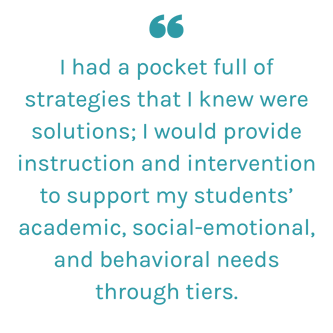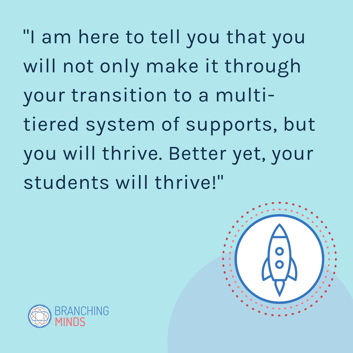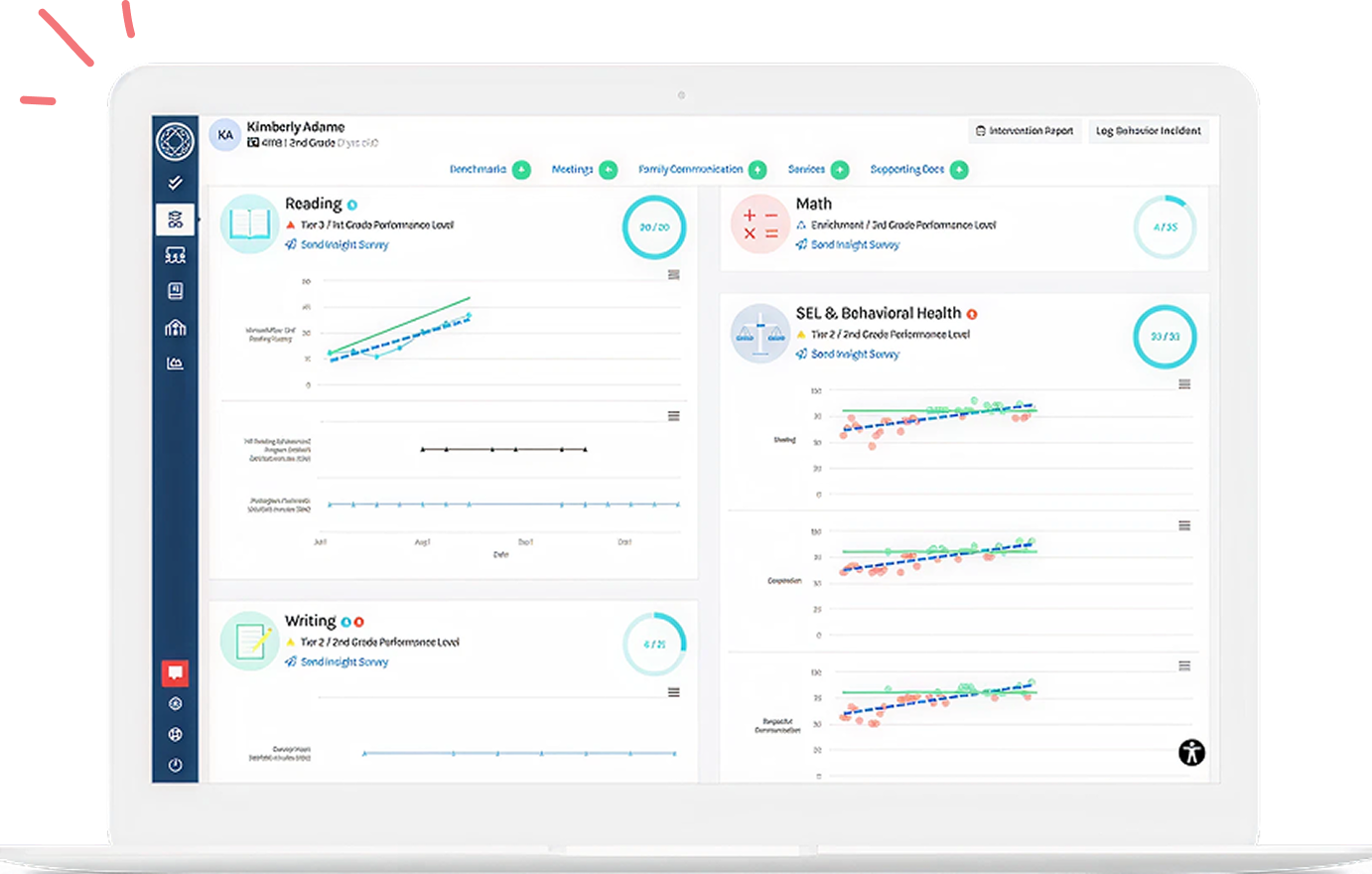I have wanted to be an educator for as long as I can remember. My FAVORITE season is back to school; the pencils, new bulletin boards, clean desks with utility crates in the center filled with markers, scissors, and dictionaries. I doubt that among readers, I am alone in this sentiment.
In 2009, I landed my first teaching position at a Title 1 school, where I spent my first five years of teaching, learning, and growing. This is where I first learned about MTSS (Multi-Tiered System of Supports). I was quick to engage in proactively supporting this new initiative. From this transition, I saw success for me AND my students at every corner—and I’m here to tell my story.
The Transition to MTSS
I taught almost every subject to 6th, 7th, and 8th-grade students during my first year. Students were moved into my room when they struggled academically or behaviorally. It was a HARD year, and I cried a lot.
The Breaking Point: Facing the Realities of a First-Year Teacher
I cried for myself, but mostly I cried for my students—because I did not know how to meet their needs. They did not teach this in college. I had students who had their clothes washed at school and students who picked up food bags to hide under their bed, so nobody stole it. I had students who could not sound out words and could not add one-digit numbers or count by fives and tens. I had students who were homeless, students responsible for younger siblings, and students who were absent for days in a row.
My classroom was not equipped with on-grade level books or materials, and I was not scheduled into a collaborative learning community, like my colleagues who only taught one subject. Nevertheless, as the year went by, I learned differentiated techniques, celebrated small successes with my students, had class parties, laughed, cried, struggled together, until (finally) we went on summer break.
"I am going to open a cupcake business!" I declared to my husband. He was a teacher at the same school when I made my summer declaration. I was not going back. I would teleport before facing the ordeal of catching another “already behind” student up after they returned from a suspension. Then, both my husband and I received letters inviting us to a summer boot camp to prepare for the upcoming year and learn about MTSS. I decided to give it a go (after all, I was a terrible baker).
The Light Bulb Moment: MTSS to the Revolutionary Rescue
During the three days of MTSS Boot Camp, we learned about tiered supports and students moving in and out of receiving interventions. We also learned about strategies to improve our Tier 1 or our everyday instruction. Looking at the research and understanding its impact, I saw how this could revolutionize my experience as a teacher and the success of my students.
To start, I knew I wanted to implement a Positive Behavior Support System and CHAMPS as essential components in my MTSS practice. These two strategies increase the instructional time spent on expectations and classroom behaviors. I also received a brief overview on Strategic Instruction Materials, and right away saw the applicability of the Frame Routine to organize and summarize our learning. I have carried these strategies with me throughout my career.
Since almost my whole class was identified as needing targeted or intensive support, I knew this was the way to improve my core instruction to better meet my students' needs. I was ENERGIZED!
The Turning Point: Starting Year Two Armed With Strategies and Hope
 And so, I entered year two. This time, I was armed with extra pencils, extra empty binders, empty backpacks, ample supplies of snacks, and a positive attitude. If you forgot a pencil, we would still do work, so borrow one from me. If you couldn't afford a binder, organization was a life skill you would still learn, so I gave my students one. If you didn't have a backpack to carry your binder, I had one for you; everyone deserves a space to store their things.
And so, I entered year two. This time, I was armed with extra pencils, extra empty binders, empty backpacks, ample supplies of snacks, and a positive attitude. If you forgot a pencil, we would still do work, so borrow one from me. If you couldn't afford a binder, organization was a life skill you would still learn, so I gave my students one. If you didn't have a backpack to carry your binder, I had one for you; everyone deserves a space to store their things.
Hungry? I know you can't learn with an empty stomach. We had learning to do, and hunger was not standing in the way. I had a pocket full of strategies that I knew were solutions; I would provide instruction and intervention to support my students’ academic, social-emotional, and behavioral needs through tiers.
The same students returned to my room, for the most part, that fall. Again, I followed the instructions to create an environment that met my learners' needs. I realized pretty early on that my classrooms' basic needs were much more than others. Now strong with resources and strategies, I created a positive behavior support system, provided differentiated activities and assessments, and spent the most time on standards that the students needed to move forward.
I refused to offer lower-level work for my students, so I began attending collaborative planning meetings with my colleagues to identify what supports were working for their students to master grade-level standards. At meetings, my colleagues would share a struggle they were having in their classroom, and I would jump at the opportunity to provide a suggestion; after all, my students put me through the wringer the year before, and I had created a bank of ideas.
Around mid-year, I still needed something more to provide interventions to students. A close colleague and I devised a plan to swap students for short blocks of time and provide targeted instruction in our areas of expertise. We were both exhausted by the end of the year but fulfilled. Our high stakes assessments results came in, and our students not only made gains, more than half of them also met grade level proficiency for the first time in their lives.
Challenges in Transitioning to MTSS
Over the next year, there were constant changes. Many of my colleagues resisted the transition to a multi-tiered system of supports, having seen many initiatives come and go during their tenure. An additional 30-minute intervention period was added to the school day. Many classrooms were moved to various areas of campus to promote grade-level teaming. Our school and district purchased an online curriculum and assessment program that all teachers were required to utilize during the intervention period.
Tensions at the Crossroads of Change
There was not much communication regarding these changes. They caused unrest and barriers between teachers and administration. I stayed close to my classroom—the practices that I knew worked—and engaged in every professional learning opportunity that I could. Our campus held weekly schoolwide student support meetings, where individual students' problem solving would occur, but due to time constraints, teachers could not attend.
Teachers had to jump through multiple hoops on a lengthy checklist to request a discussion for a student in need of support. After the meetings, administrators sent notes and directions to teachers in the classroom to make changes to their instruction to support the students after these meetings. Unfortunately, there was a disconnect between the teachers and the problem-solving processes.
➡️ On-Demand Webinar: Effective Meeting Structures in an RTI/MTSS Practice
The Power of Collaboration
I strode into my classroom like a seasoned veteran by my fourth year of teaching. I had experienced pretty much everything at that point. It was my third year working within an MTSS framework, and I knew that we needed something more. I worked with my administration to create a part-time special assignment providing targeted support across the campus.
Using MTSS to Move Forward Together
In this negotiation, I taught for three class periods, and I supported various students identified by their teachers as struggling the remainder of the day. The goal was not to have so much "front office problem-solving” but to create a more collaborative problem-solving approach that began with more support in the classrooms.
It was exhausting, but we learned a lot about collaboration between classroom teachers, teacher leadership, and administration. By the next year, I provided this targeted support work full-time and coached teachers to utilize stronger evidence-based practices in their Tier 1 instruction.
Our campus' master schedule had many inclusion classrooms; I was one of two support interventionists. Our administrators adopted an intervention curriculum for Tier 2 support in reading. We created a ticket system for collaborative learning communities to refer students to individual problem-solving. We built a collaborative leadership team that consisted of administrators, interventionists, counselors, teachers, and paraprofessionals who reviewed campus-wide academic and discipline data regularly and made suggestions to improve processes.
Everyone shared the load and responsibilities of intervention and progress monitoring for students that needed additional support. As a result, we saw a significant decrease in behaviors and the lowest number of students ever needing summer school to pass.
The Power of System-Level Leadership
Last year was my 12th year in education in the same school district. As a district-level administrator, I had the privilege of coaching many of the 43 schools in my large Florida district to expand their MTSS practices. In 2020, alongside the same trainer that trained me on MTSS ten years before, I coached 35 schools to earn Model PBIS Resiliency School Awards. Based on our data, it was clear that MTSS was having a systemic, positive impact on our school climate.
In addition, the district embarked on a self-assessment of MTSS, a fidelity measure to identify Model MTSS Schools and Districts in the state of Florida beginning this school year. I am so proud to have been a part of the transition and even more proud to have the opportunity to spread the love and support for MTSS across the country through Branching Minds.
Reflections of an MTSS Journey
Over winter break this year, a friend invited me to hear a speaker. She shared a story about butterflies. Butterflies don't start beautiful butterflies; they begin as caterpillars, and caterpillars transition through many stages.
During the chrysalis stage, the caterpillar completely decomposes, turning to liquid, and from that, the butterfly emerges. So, I am sure you’re asking, “How does decomposing chrysalis relate to MTSS, Brittany?”
Remember, as you’re transitioning through something difficult and experiencing those growing pains, you’re just growing through bug juice. Soon enough, you will make it out, and the result is something more beautiful and different than we could have imagined.
Move Through Discomfort, It Won't Last Forever
 This butterfly metaphor is the best way to describe the transition that happened during my formative years of teaching and introduction to MTSS. It’s the same transition that many teachers are experiencing now; feelings of discomfort and uncertainty. But don’t fret. We’re just growing through the bug juice.
This butterfly metaphor is the best way to describe the transition that happened during my formative years of teaching and introduction to MTSS. It’s the same transition that many teachers are experiencing now; feelings of discomfort and uncertainty. But don’t fret. We’re just growing through the bug juice.
I am here to tell you that you will not only make it through your transition to a multi-tiered system of supports, but you will thrive. Better yet, your students will thrive!
Based on my experience, I’ve gathered some guidelines and reflections for educators currently going through their own transition to MTSS.
Here Are a Few Tips That Made the Transition to MTSS Successful…
- Find marigolds and be a marigold. The Cult of Pedgagoy (2013) shared a story about teachers that are marigolds. The marigold is a plant that farmers plant near crops to help them grow. Plant yourself near teachers who want to grow and see you succeed. Better yet, BE A MARIGOLD. Help and encourage others to grow in this great profession.
- When I tried to implement a multi-tiered system of supports alone, I changed my instructional practices. When my administrators attempted to implement a multi-tiered system of supports without teachers, they changed process requirements. While checklists and decision rules are great tools, without proper training and support, teachers could not utilize the structures to better students’ learning. When we worked together as teachers and leaders, we aligned our processes and practices to change our students' lives.
- Finally, know that creating a system takes time, mistakes, change, and elbow grease. Even after five years, continuous change and growth had to take place. When we know better, we do better. If we are not changing, are we getting any better? Instead of pushing against change, be proactive in aligning change within your multi-tiered framework. Where does it fit in your classroom or for what students? With change comes mistakes. Apologize. Strive to do your best. Communicate positively and proactively with your colleagues, administrators, and families.
Let us help you build the right team!Branching Minds offers a variety of professional learning opportunities for states, districts, and schools to ensure instructional leaders, specialists, coaches, and teachers are able to implement RTI/MTSS as well as the BRM platform with fidelity and maximizes educators’ efforts to accelerate learning for all students. |
![[Guest Author] Brittany Shurley-avatar](https://www.branchingminds.com/hs-fs/hubfs/image0.jpeg?width=82&height=82&name=image0.jpeg)
About the author
[Guest Author] Brittany Shurley
Brittany Shurley has served students, educators, and leaders in various roles throughout her career including as a classroom teacher, learning disabilities specialist, school-based leader, and district level administrator. Brittany has extensive experience in facilitating the implementation of an MTSS at the district and school levels. She is passionate about ensuring teachers have the tools to promote safe, healthy, and engaging learning environments where students are experiencing success.

Your MTSS Transformation Starts Here
Enhance your MTSS process. Book a Branching Minds demo today.




















